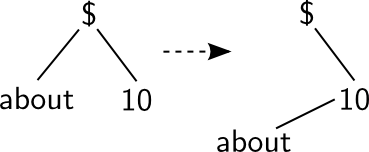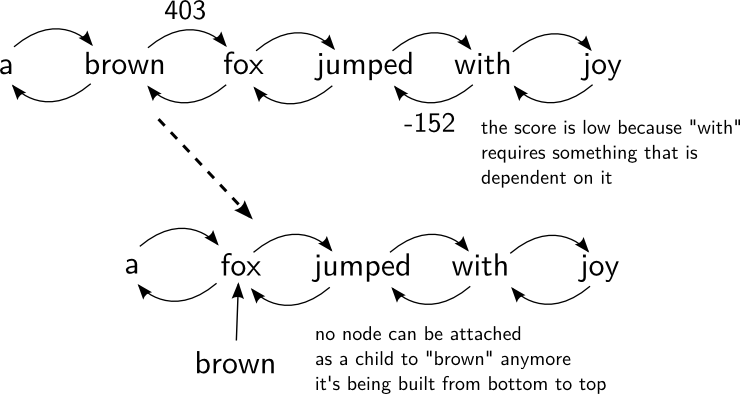Table of Contents
A Fast, Accurate, Non-Projective, Semantically-Enriched Parser
written by Stephen Tratz and Eduard Hovy (Information Sciences Institute, University of Southern Carolina)
presented by Martin Popel
reported by Michal Novák
Introduction
The paper describes a high-quality conversion of Penn Treebank to dependency trees. The authors introduce an improved labeled dependency scheme based on the Stanford's one. In addition, they extend the non-directional easy-first first algorithm of Goldberg and Elhadad to support non-projective trees by adding “move” actions inspired by Nivre's swap-based reordering for shift-reduce parsing. Their parser is capable of producing shallow semantic annotations for prepositions, possesives and noun compounds.
Notes
Dependency conversion structure
- in general, there are (at least) 3 possible types of dependency labels:
- unlabeled - is it really a set of labels?
- coarse labels of the CoNLL tasks
- 10-20 labels
- for example NMOD is always under a noun - it's an easy task and the result is not quite useful
- their scheme is based on the Stanford's dependency labels
Conversion process
- converting phrase trees of Penn Treebank to dependency ones
- it consists of 3 steps:
- add structure to flat NPs
- constituent-to-dependency converter with some head-finding rule modifications
- a list of rules in Figure 2 is hardly understandable without reading a paper their conversion method is related to
- they reduced the number of generic “dep/DEP” relation
- Stanford tags are hierarchical and “dep/DEP” is the top-most one
- correcting of POS using the syntactic info + additional rules for specific word forms
- additional changes and the final conversion from the intermediate output to a dependency structure
Parser
- we illustrated a step of the parser:
- we compared time complexity of this system with other commonly used ones
| MST parser | <latex>\mathop O(n | 2)</latex> | ||
|---|---|---|---|---|
| MALT parser | <latex>\mathop O(n)</latex> | in fact slower | ||
| this parser | <latex>\mathop O(n\log(n))</latex> | <latex>\mathop O(n | 2)</latex> - naive implementation | |
| this parser - non-projective | <latex>\mathop O(n | 2\log(n))</latex> | <latex>\mathop O(n | 3)</latex> - naive implementation |
- implemented by a heap, it can reach <latex>\mathop O(n\log(n))</latex>; however, they don't use it because it's fast enough
- Algorithm1
- we weren't sure what the variable “index” is (best index of parent or any index of queue of unprocessed words)
- it again confirms that pseudocode is usually more confusing than a normal code or verbal explanation
- “move” operation:
Features
- Brown et al. clusters - they are surprisingly used rarely
Features
- not much discussed in the paper
Evaluation
- they make the same transformation as they did in Section 2
Shallow semantic annotation
- 4 optional modules
- preposition sense disambiguation
- noun compound interpretation
- possesives interpretation
- PropBank semantic role labelling
- (Hajič et al., 2009) is not in the list of references
Conclusion
- non-directional easy-first parsing
- new features - Brown et al. clusters
- fast and accurate
- modified Penn converter
- changes in 9.500 POS tags
- labels copula, coordination
- semantic info



